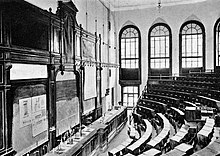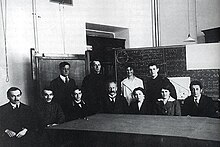Peter the Great St. Petersburg Polytechnic University
Санкт-Петербургский политехнический университет Петра Великого | |
 | |
Former name | Saint Petersburg State Technical University |
|---|---|
| Type | Public / National research university |
| Established | 1899 |
| Endowment | US $298 million |
| President | Mikhail P. Fedorov |
| Rector | Andrey I. Rudskoy |
Academic staff | 3291 |
Administrative staff | 1,940[1] |
| Students | 32,250[1] |
| Address | Polytechnicheskaya 29, 195251 , , Russian Federation |
| Campus | Urban, city center, 102 hectares |
| Colours | Green/Golden |
| Nickname | Polytechnicheskiy Institute |
| Mascot | Two-Headed Eagle |
| Website | www.spbstu.ru |
Peter the Great St. Petersburg Polytechnic University, abbreviated as SPbPU (also, formerly "Saint Petersburg State Technical University", abbreviated as SPbSTU), is a major Russian technical university located in Saint Petersburg. Other former names included Peter the Great Polytechnic Institute (Политехнический институт императора Петра Великого) and Kalinin Polytechnic Institute (Ленинградский политехнический институт имени Калинина). The university is considered to be one of the top research facilities in Russian Federation and CIS member states and is a leading educational facility in the field of applied physics and mathematics, industrial engineering, chemical engineering, aerospace engineering and other academic disciplines. It houses one of the country's most advanced research labs in hydro–aerodynamics. The university's alumni include famous Nobel Prize winners, such as Pyotr Kapitsa, prominent nuclear physicists and atomic weapon designers such as Yulii Khariton and Nikolay Dukhov world-class aircraft designers and aerospace engineers, such as Yulii Khariton, Oleg Antonov, Nikolai Polikarpov and Georgy Beriev. The university offers academic programs at the Bachelor, Master's and Doctorate degree levels. SPbSPU consists of structural units called Institutes divided into three categories:[2]
- Engineering Institutes
- Physical Institutes
- Economics and Humanities Institutes
History[]
Official names[]
The university has undergone several name changes throughout its existence. Detailed list of name changes is as following:
- 1899–1910 – Saint Petersburg Polytechnic Institute (Санкт-Петербургский политехнический институт)
- 1910–1914 – Saint Petersburg Peter the Great Polytechnic Institute (Санкт-Петербургский политехнический институт императора Петра Великого)
- 1914–1922 – Petrograd Peter the Great Polytechnic Institute (Петроградский политехнический институт императора Петра Великого)
- 1922–1923 – First Petrograd Polytechnic Institute (Первый Петроградский политехнический институт)
- 1923–1924 – Petrograd Polytechnic Institute (Петроградский политехнический институт)
- 1924–1930 – Leningrad Polytechnic Institute (Ленинградский политехнический институт)
- 1930–1934 – Divided into various colleges and branches under a variety of names.
- 1934–1940 – Leningrad Industrial Institute (Ленинградский индустриальный институт)
- 1940–1990 – Leningrad Polytechnic Institute (Ленинградский политехнический институт)
- 1990–1991 – Leningrad State Technical University (Ленинградский государственный технический университет)
- 1991–2002 – Saint-Petersburg State Technical University (Санкт-Петербургский государственный технический университет)
- 2002–2015 – Saint Petersburg State Polytechnic University (Санкт-Петербургский государственный политехнический университет)
- Since 2015 – Peter the Great St. Petersburg Polytechnic University (Санкт-Петербургский политехнический университет Петра Великого)
Imperial Russia[]

Saint Petersburg Polytechnic Institute was founded in 1899 as the most advanced engineering school in Russia. The main person promoting the creation of this university was the Finance Minister Count Sergei Witte. Witte viewed establishing a first-class engineering school loosely modeled by the French École Polytechnique as an important step towards the industrialization of Russia. The idea was advanced by agricultural scientist and Deputy Finance Minister Vladimir Kovalevsky and the chemist Dmitri Mendeleev who are often considered to be the founders of the school.
The first director of the institute became Prince Andrey Gagarin. Ivan Meshersky was professor of St. Petersburg Polytechnic Institute. Unlike the French École Polytechnique, the Saint Petersburg Polytechnic Institute was always considered to be a civilian establishment. In tsarist Russia it was subordinated to the Ministry of Finance; its students and faculty wore the uniform of the ministry.

The main campus was built by the architect (Эрнст Францевич Виррих) on the rural lands beyond the dacha settlement Lesnoye. The location was intended to provide some separation between the campus and the capital city of Saint Petersburg.
The institute was opened to students on October 1, 1902. Originally there were four departments: Economics, Shipbuilding, Electro-mechanics and Metallurgy.
Its work was interrupted by the Russian Revolution of 1905. One student, M. Savinkov, was killed during the Bloody Sunday events of January 22 [O.S. January 9] 1905. The reaction of the student body was so strong that classes only resumed in September 1906, almost two years later. Among the polytechnic students who participated in the Revolutionary events were the future Bolshevik leader Mikhail Frunze and the future writer Yevgeny Zamyatin. Among the deputies of the First Duma were four Polytechnic Institute's faculties: N.A. Gredeskul (Н.А. Гредескул), N.I. Kareev (Н.И. Кареев), A.S. Lomshakov (А.С. Ломшаков) and L.N. Yasnopolsky (Л.Н. Яснопольский).
In 1909 the Shipbuilding Department opened the School of Aviation. It was the first aviation and aerodynamics school in Russia. In 1911 the same department opened the School for Car Manufacturing.
In 1910 the institute was named Peter the Great Polytechnic Institute after Peter I of Russia. In 1914 the number of students reached 6,000.

With the onset of World War I many students found themselves in the Army and soon the number of students decreased to 3,000. Some students, like future Soviet military commander Leonid Govorov studied at the institute for one month. Part of the institute's buildings were transferred into the Maria Fyodorovna Hospital at that time the largest military hospital in Russia.
Despite the war the institute did not stop its work. In 1916 Abram Ioffe opened his Physics Seminar at the Polytechnic Institute. The seminar prepared three Nobel Prize-winners and many other prominent Russian physicists. Eventually, this seminar became the core of the Ioffe Physico-Technical Institute.
Revolution[]
On June 5, 1918 the institute was renamed to First Polytechnic Institute (with the Second Polytechnic Institute being the former Women's Polytechnic Institute). In November 1918 Sovnarkom abolished all forms of scientific decrees, licenses and certifications. There remained only two positions for the faculty: Professor (that required three years of engineering experience) and instructor (with no formal requirements at all). Departments were renamed Faculties (факультеты), and the director became rector. A Soviet (Council) of 11 professors and 15 students was given the main authority in the Institute. One of these 15 students in the Soviet was Pyotr Kapitsa, the future Nobel-prize winner in physics.
In March 1919 two additional faculties were formed: the Faculty of Physics and Mechanics (fizikomekhanicheskij) and Chemical (khimicheskij). The Faculty of Physics and Mechanics, headed at that time by Abram Ioffe, focused on atomic and the solid state physics, which was notably progressive for an Engineering school of 1918.
In winter of 1918/1919 there were food shortages and no heating on campus due to fuel shortages; many students and faculty members died of starvation and freezing temperatures. In the beginning 1919 there were only around 500 students at the University. In August 1919 the new semester started but on August 24 all the students were mobilized to fight Yudenich army. The Institute itself was encircled by stanchions and barbed wire and transformed into a Red Army fortification. After December 1919 the Institute was completely empty.
Soviet Era[]
The Institute started working again in April 1920 when it became a part of the planning team for the GOELRO plan. Professor of the Institute, A. V. Wulf was the chairman of the group working on the electrification of the Northern Region of RSFSR. The Institute developed projects of the Volkhov hydroelectric dam on the Volkhov River and the Dnieper Hydroelectric Station on the Dnieper River.
In autumn 1920, due to the cold weather and the absence of heating some lectures were only attended by one or two students. At that difficult time Nikolay Semyonov and Pyotr Kapitsa discovered a way to measure the magnetic field of an atomic nucleus. Later the experimental setup was improved by Otto Stern and Walther Gerlach and became known as Stern–Gerlach experiment. In another laboratory another student of the Institute, Léon Theremin worked on the development of electronic musical instruments. His first demonstration of the theremin was held in Polytechnic Institute on November 1920.
After the end of the Russian Civil War many students returned to the Institute. By the spring of 1922 there were 2800 students on the campus. In the Autumn of 1922 the Institute obtained the new Agricultural Faculty at the site of the closed Agricultural Institute in Tsarskoe Selo.
In 1926, Sovnarkom re-established the title Engineer and allowed "children of working intelligentsia" to enter the tertiary schools; prior to this only workers and children of workers were allowed. The number of students enrolled at the Polytechnic Institute reached the 1914 level of 6,000. By 1928 there were 8,000 students. In 1929 two new faculties were opened: Construction of Aircraft and Water Resources.
In 1930, Sovnarkom decided to create a network of highly specialized Engineering schools. On June 30 Polytechnic Institute was closed and a number of independent institutes were created instead:
- Hydrotechnical (Гидротехнический),
- Industrial Civil Engineering (Институт инженеров промышленного строительства), now the Military engineering-technical university (Военный инженерно-технический универ.),
- Shipbuilding (Кораблестроительный),
- Aviation (Авиационный),
- Electrotechnical (Электротехнический),
- Chemical Technology (Химико-технологический),
- Metallurgy (Металлургический),
- Machine Building (Машиностроительный),
- Industrial Agriculture (Индустриального сельского хозяйства),
- Physics and mechanics (Физико-механического),
- Finances and Economics (Финансово-экономический) and
- Boilers and Turbines (Всесоюзный котлотурбинный).
Soon another Institute of Military Mechanics forked from the Machine Building Institute.
In April 1934, most of these institutes were merged back into the Leningrad Industrial Institute. In 1935 it was the largest engineering school in the Soviet Union, with ten thousand students, 940 professors and teachers, and 2600 support staff.
In November 1940, the Institute almost got its original name back. Now it was named the Kalinin Politechnical Institute (Leningradskij Politekhnicheskij Institut imeni Kalinina) after the President of the Presidium of the Supreme Soviet Mikhail Kalinin.

With the onset of the eastern front of World War II, 3500 students went to the army and hundreds were involved in constructing fortifications to the university itself. The main building was transformed into a hospital and another building was used as a tank school. Institute shops filled military contracts. On September 8, 1941 the Siege of Leningrad began. Research on the strength of ice by employees S. S. Golushkevich, P. P. Kobeko, N. M. Reyman and A. R. Shulman proved the feasibility of transporting vital materials across ice. The researchers selected the safest route for the Road of Life - the transport route across the frozen Lake Ladoga, which provided the only access to the besieged city.
Some faculties and students were evacuated to Tashkent in January 1943 where they were able to hold classes. In November 1943 they restarted classes in Leningrad as well. In 1943 in Leningrad there were 250 students and 90 teachers at the Institute. The Polytechnic Institute was the only school in the besieged city that had the authority to evaluate the Kandidat (Ph.D) and Doctor of Science dissertations. Before the end of the siege the Polytechnic Institute evaluated 19 dissertations, many related to military defense. After the end of the war the Institute was rebuilt.
In 1952, Radio-physics Department was created.
In 1988, the new Physics-Technical (Fiziko-Tekhnichesky) Department (faculty) of the Institute was created. The department was modeled on the Ioffe Physico-Technical Institute and headed by the director of the Ioffe Institute Zhores Ivanovich Alferov, recipient of the 2000 Nobel prize in physics.
Current status[]
In September 1991 Leningrad returned its historical name Saint Petersburg and the Institute was renamed St. Petersburg State Technical University (the word "Technical" was changed to "Polytechnic" in 2002). Finally, in 2015, the institute took its current name Peter the Great St. Petersburg Polytechnic University.[3] However, it is often still referred to as the Polytechnic Institute.
Today the Polytechnic University is a large educational complex that includes 23 Institutes and Faculties, 6 associated institutes outside Saint Petersburg in the cities of Pskov, Cheboksary, Cherepovets, , Smolensk and Anadyr, and many scientific research laboratories. There are over 30,000 students including 1,100 postgraduates and 3,000 international students.
Campus[]
The campus consists of[4]
- Total area – 109 hectares
- Total number of buildings – 112
- Total number of students – 30,197 (including 2,916 foreign students)
- Teaching staff – 3,300
- University staff – 5,274
- Students dormitories – 15 buildings
- Dormitories area – 43,076 sq.m
Structural units[]
- Joint Science and Technology Institute
- 21 faculties and institutes
- Over 150 departments 120 R&E laboratories
- 26 research and educational centers
- More than 20 small innovative enterprises
- Science park and incubating
- Faculty of foundation programs and institute of professional education
- 3 branches and 6 representatives
- St. Petersburg College of Information and Management
Infrastructural units[]
- Fundamental Library
- Exhibition complex
- Publishing House
- Sport and Recreation Complex:
- Stadium
- Gymnastic halls
- Tennis courts
- Swimming pool
- Student Dormitories for 5,000 residents
- Student Dormitories for 1,200 international students
- Northern and Southern Vacation Camps
- Students' Club
- Medical Complex
- House of Scientists in Lesnoye
- Catering Complex
Students[]
More than 30,000 students are enrolled in the university. Due to the international reputation of the Polytechnic University as a world-class institute in applied physics and mathematics, over 3,000 foreign students enroll to obtain international bachelor's (4 year) and master's (2 year) degrees. International students countries of origin include US, UK, France, Germany, Finland, Sweden and most of the CIS state members. Another factor driving international enrollment is that the tuition cost for a B.S. or M.S. degree can run approximately 4–5 times less than a typical US college, and courses are taught in Russian and English languages.
Department enrollment[]
Proportion of student body enrolled in each department
- Life safety, Environmental engineering and Environmental protection – 2%
- Computer science – 7%
- Automation and Control – 7%
- Economics and Management – 23%
- Architecture and Construction – 10%
- Physical and Mathematical sciences – 5%
- Humanities – 8%
- Culture and Art – 1%
- Information Security – 2%
- Energy, Power engineering and Electrical engineering – 17%
- Metallurgy, Machinery and Materials processing – 10%
- Vehicles and Technical machines – 3%
- Instrumentation and Optical engineering – 1%
- Electronic engineering, radio engineering and communication – 4%
Alumni and faculty[]
In total the University has graduated over 150,000 students. Notable alumni and faculty include:
- First cosmonaut Yuri Gagarin
- Nobel Prize winners Pyotr Kapitsa, Nikolay Semyonov, and Zhores Alferov
- Former president of the Russian Academy of Sciences Anatoly Alexandrov
- Academicians Igor Kurchatov, Georgy Flyorov and Abram Ioffe
- Nuclear weapon designers Yulii Khariton and Nikolay Dukhov
- Aircraft designers Yulii Khariton, Oleg Antonov, Nikolai Polikarpov and Georgy Beriev
- Designer of the T-34 tank, Mikhail Koshkin
- Chess grandmaster David Bronstein
- Writer Daniil Granin
- Writer Yevgeny Zamyatin
- Navy Admiral Aksel Berg
- US journalist Matt Taibbi
- Theology lecturer Grigory Spiridonovich Petrov
- Former Turkmenistan president Saparmurat Niyazov[5]
- First Azerbaijani woman to be a professional metallurgist, Gjuvara Noerieva[6]
- Kirovs Lipmans – Latvian business person and ice hockey executive[7]
World ranking[]
- 2013/14: 441–460 in QS World University Rankings[8]
- 2016/17: 411–420 in QS World University Rankings[9]
- 2018: 401–410 in QS World University Rankings[10]
- 2019: 85 in Times Higher Education (THE) World University Rankings.[11] 404 in QS World University Rankings[12]
- 2020: 37 in Times Higher Education (THE) World University Rankings, the best Russian university.[13] 439 in QS World University Rankings[14]
- 2021: 401 in QS World University Rankings.[15] 126–150 in Times Higher Education (THE) World University Rankings in "Engineering", the best Russian technical university[16]
References[]
- ^ Jump up to: a b Facts & Figures - Peter the Great St.Petersburg Polytechnic University (SPbPU)
- ^ "Institutes". www.spbstu-eng.ru. Retrieved Jul 31, 2019.
- ^ Decision N 407 of the Russian Ministry for Education and Science (2017) Archived 2017-09-18 at the Wayback Machine: on the status of Peter the Great St. Petersburg Polytechnic University (s. pages 4-6 in the file for chronology of renamings).
- ^ https://www.spbstu.ru/
- ^ правды», Александр ГАМОВ, Андрей СЕДОВ, Максим ЧИЖИКОВ, Ольга ВАНДЫШЕВА, Александр ЗЮЗЯЕВ, Нигина БЕРОЕВА, Кирилл АНТОНОВ | Сайт «Комсомольской (Dec 22, 2006). "Наследником Туркменбаши может стать следователь московской прокуратуры". KP.RU - сайт «Комсомольской правды». Retrieved Jul 31, 2019.
- ^ Исмаилов, Эльдар Эльхан оглы (2009). Персидские принцы из дома Каджаров в Российской империи. М.: Старая Басманная. Ответственный редактор - Молчанов, Аркадий Анатольевич.
- ^ "Kirovs Lipmans". Latvian Sports (in Latvian). 2015. Retrieved 29 August 2021.
- ^ "Российские вузы в Мировом рейтинге QS - РИА Новости, 10.09.2013". Ria.ru. 10 September 2013. Retrieved 2019-07-31.
- ^ "Peter the Great Saint-Petersburg Polytechnic University". Top Universities. Jul 16, 2015. Retrieved Jul 31, 2019.
- ^ "QS World University Rankings 2018". Retrieved 2021-03-20.
- ^ "THE World University Rankings 2019". 2 April 2019. Retrieved 2021-03-20.
- ^ "QS World University Rankings 2019". Retrieved 2021-03-20.
- ^ "THE World University Rankings 2020". Retrieved 2021-03-20.
- ^ "QS World University Rankings 2020". Retrieved 2021-03-20.
- ^ "QS World University Rankings 2021". Retrieved 2021-03-20.
- ^ "Peter the Great Saint-Petersburg Polytechnic University". THE Top Universities. March 18, 2021. Retrieved March 18, 2021.
- Official Website of the Saint Petersburg State Polytechnic University
- 2011 Official Academic Rankings of World Universities
- Peter the Great St.Petersburg Polytechnic University in the project Study in Russia
Coordinates: 60°00′26.41″N 30°22′22.66″E / 60.0073361°N 30.3729611°E
- Peter the Great St. Petersburg Polytechnic University
- Educational institutions established in 1899
- Technical universities and colleges in Russia
- Engineering universities and colleges in Russia
- 1899 establishments in the Russian Empire
- National research universities in Russia

